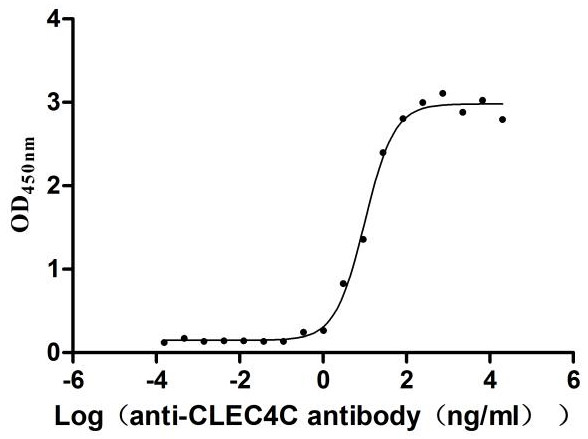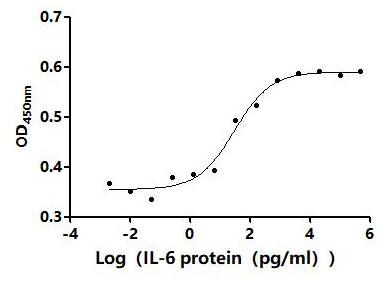Recombinant Human immunodeficiency virus type 2 subtype A Protein Vpx (vpx)
In Stock-
中文名称:Recombinant Human immunodeficiency virus type 2 subtype A Protein Vpx(vpx)
-
货号:CSB-EP325553HLU
-
规格:¥2328
-
图片:
-
其他:
产品详情
-
纯度:Greater than 90% as determined by SDS-PAGE.
-
基因名:vpx
-
Uniprot No.:
-
别名:vpxProtein Vpx; Viral protein X; X ORF protein
-
种属:Human immunodeficiency virus type 2 subtype A (isolate BEN) (HIV-2)
-
蛋白长度:Full Length
-
来源:E.coli
-
分子量:17.2kDa
-
表达区域:1-113aa
-
氨基酸序列MTDPRERVPPGNSGEETIGEAFEWLERTIEALNREAVNHLPRELIFQVWQRSWRYWHDEQGMSASYTKYRYLCLMQKAIFTHFKRGCTCWGEDMGREGLEDQGPPPPPPPGLV
Note: The complete sequence including tag sequence, target protein sequence and linker sequence could be provided upon request. -
蛋白标签:N-terminal 6xHis-tagged
-
产品提供形式:Liquid or Lyophilized powder
Note: We will preferentially ship the format that we have in stock, however, if you have any special requirement for the format, please remark your requirement when placing the order, we will prepare according to your demand. -
缓冲液:If the delivery form is liquid, the default storage buffer is Tris/PBS-based buffer, 5%-50% glycerol.
Note: If you have any special requirement for the glycerol content, please remark when you place the order.
If the delivery form is lyophilized powder, the buffer before lyophilization is Tris/PBS-based buffer, 6% Trehalose. -
储存条件:Store at -20°C/-80°C upon receipt, aliquoting is necessary for mutiple use. Avoid repeated freeze-thaw cycles.
-
保质期:The shelf life is related to many factors, storage state, buffer ingredients, storage temperature and the stability of the protein itself.
Generally, the shelf life of liquid form is 6 months at -20°C/-80°C. The shelf life of lyophilized form is 12 months at -20°C/-80°C. -
货期:3-7 business days
-
注意事项:Repeated freezing and thawing is not recommended. Store working aliquots at 4°C for up to one week.
-
Datasheet & COA:Please contact us to get it.
相关产品
靶点详情
-
功能:Plays a role in nuclear translocation of the viral pre-integration complex (PIC), thus is required for the virus to infect non-dividing cells. Targets specific host proteins for degradation by the 26S proteasome. Acts by associating with the cellular CUL4A-DDB1 E3 ligase complex through direct interaction with host VPRPB/DCAF-1. This change in the E3 ligase substrate specificity results in the degradation of host SAMHD1. In turn, SAMHD1 depletion allows viral replication in host myeloid cells by preventing SAMHD1-mediated hydrolysis of intracell...显示更多
-
基因功能参考文献:
- These results indicate that Vpx, in addition to SAMHD1, overcomes a previously unappreciated restriction for lentiviruses at the level of reverse transcription (RT)that acts independently of dNTP concentrations and is specific to resting CD4 T cells. PMID: 28228523
- zinc binding appears to mitigate flexibility of the three-helix fold of Vpx, thereby preventing dysfunction. PMID: 28284276
- Data indicate that proline residue P109 within the C-terminal poly-proline motif (PPM) of Vpx protein plays a unique role in the regulation of SAM domain and HD domain 1 protein SAMHD1 degradation. PMID: 25936766
- HIV-2 Vpr can trigger G2 cell cycle arrest through either CUL4A or CUL4B. PMID: 24719410
- Vpx expression results in decreased promoter binding activity of IRF5 PMID: 24532789
- Poly-proline motif in Vpx is critical for its efficient expression in cells. PMID: 24114794
- Data suggest that, in an evolutionary model of virus-host interactions, binding of Vpx/Vpr with SAMHD1 (and subsequent degradation of SAMHD1 [SAM domain/HD domain-containing protein 1]) exhibits dynamic requirements that have toggled back and forth. PMID: 23874202
- the crystal structure of a ternary complex of Vpx with the human E3 ligase substrate adaptor DCAF1 and the carboxy-terminal region of human SAMHD1 PMID: 24336198
- direct down-modulation of Vpx catalytic activity, mediated by the same binding event that leads to SAMHD1 recruitment to the E3 ubiquitin ligase for proteasome-dependent degradation PMID: 23677995
- Effective immune control of viral replication in HIV-2-infected individuals is not associated with increased Vpx-mediated degradation of SAMHD1. PMID: 23497283
- there are several Vpx residues required for SAMHD1 degradation PMID: 23076149
- The Vpx lentiviral accessory protein targets human SAMHD1 for degradation in the nucleus. PMID: 22973040
- Vpx targets SAMHD1 for degradation in a viral strategy to control cellular deoxynucleotide levels for efficient replication PMID: 22069334
- structure and cytopathogenic activity PMID: 16153874
- These studies map critical residues of the Vpx nuclear localization signal that are required for efficient infection of non-dividing cells. PMID: 16325220
- We found that insertion within the polyproline-containing C-terminus destabilizes nuclear localization, whereas mutating a second helix in the central domain disrupts viral packaging. PMID: 16457868
- results indicated that Vpx and Vpr of HIV-2 may cooperatively contribute to virion infectivity without affecting virion morphogenesis PMID: 16953064
- The results here clearly demonstrated that the entire Vpx protein is critical for reverse transcription of the HIV-2 genome in human monocyte-derived macrophages. PMID: 18495778
- when transferred in the context of a replication-competent viral clone, Vpx was required for replication in dendritic cells PMID: 18829761
- Vpx diverts the Cul4A-DDB1(DCAF1) ligase to inactivate an evolutionarily conserved factor, which restricts macrophage infection by HIV-2. PMID: 19264781
收起更多
-
亚细胞定位:Virion. Host nucleus.
-
蛋白家族:Lentivirus VPX protein family
-
数据库链接:
KEGG: vg:1724714




















